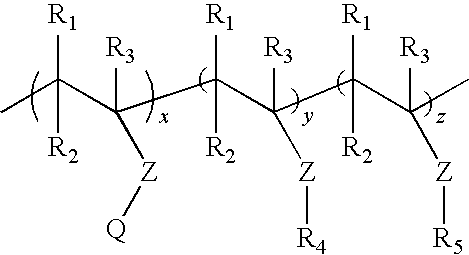Process for preparing an aqueous dispersion of a quaternary ammonium salt containing vinyl copolymer
a technology vinyl copolymer, which is applied in the field of preparing aqueous dispersion of quaternary ammonium salt containing vinyl copolymer, can solve the problems of limited application of the disclosed terpolymer as a flushable binder material to geographical areas, reduced initial sheet wettability, increased dry sheet stiffness, etc., and achieves the present process commercially economical and feasible, high purity, and easy removal
- Summary
- Abstract
- Description
- Claims
- Application Information
AI Technical Summary
Benefits of technology
Problems solved by technology
Method used
Image
Examples
example 1
Preparation and Evaluation of an Ion Sensitive Cationic Polymer
[0025]Preparation:
[0026]Acetone (a product of VWR of Westchester, Pa., 444.14 grams) and deionized water (148.05 grams) were charged to a 3-liter round bottom flask equipped with a reflux condenser, stirring means, and a thermocouple. This mixture was cooled in an ice water bath and bubbled with nitrogen for 20 minutes to remove oxygen. After the 20 minutes, the reaction mixture was maintained under a positive pressure of nitrogen and the temperature was raised to the boiling point of the mixture (about 60° C.) using a heating mantle as the heat source.
[0027]A first monomer mixture was prepared by mixing 9.15 grams of deionized water and 39.32 grams of Adamquat MC-80 (an 80% aqueous solution of [(2-acryloxy)ethyl]trimethylammonium chloride, a product of Atofina, Philadelphia, Pa.). A second monomer mixture was prepared by mixing 335.26 grams of methyl acrylate (Sigma-Aldrich, St. Louis, Mo.), 51.08 grams acetone, and 2.2...
examples 2-5
Preparation and Evaluation of Ion Sensitive Cationic Polymers Using Recycled Distillate
[0038]Preparation:
[0039]The polymer composition of Example 1 was prepared in a manner substantially similar to the procedure of Example 1. Since the distillate contained methyl acrylate, some Adamquat and VAZO 52 were added at the start of the polymerization to normalize the monomer composition in the flask. Likewise, some correction was made for slight differences in the acetone / water ratio in the distillate. The following is a tabulation of these changes and the resulting products of the reaction. The acetone distillate from Example 1 was used in the polymerization process of Example 2 while the acetone distilled from Example 2 was used in the polymerization process of Example 3. Likewise, the acetone distilled from Example 3 was used in the polymerization process of Example 4 and the acetone distilled from Example 4 was used in the polymerization process of Example 5.
[0040]
ParameterExample 2Exa...
examples 6-8
Another Preparation and Evaluation of Other Ion Sensitive Cationic Polymers Varying the Initiator Level
PUM
| Property | Measurement | Unit |
|---|---|---|
| solubility | aaaaa | aaaaa |
| weight average molecular weight | aaaaa | aaaaa |
| weight average molecular weight | aaaaa | aaaaa |
Abstract
Description
Claims
Application Information
 Login to View More
Login to View More - R&D
- Intellectual Property
- Life Sciences
- Materials
- Tech Scout
- Unparalleled Data Quality
- Higher Quality Content
- 60% Fewer Hallucinations
Browse by: Latest US Patents, China's latest patents, Technical Efficacy Thesaurus, Application Domain, Technology Topic, Popular Technical Reports.
© 2025 PatSnap. All rights reserved.Legal|Privacy policy|Modern Slavery Act Transparency Statement|Sitemap|About US| Contact US: help@patsnap.com



